One of the hardest things for authors to do is summarize an entire story idea in just a few sentences. But if you’re an author who wants to market a book, you can’t escape writing a book description. And writing one while you’re drafting helps distill your story idea to its most powerful parts.
Once you’re selling your work, you’ll need to write a compelling book description for your online listings. There are two tools that can help you with this: a book description generator and a book description template.
We’ll take a look at both.
Book description generators
A book description generator can help you with the task of creating the perfect summary, but don’t let the title fool you: a book description generator can’t write a book description for you.
Because no one else knows your novel like you do, a book description generator can’t create a description unless you… describe your book and enter that into the generator. That would defeat the purpose!
Instead, a book description generator gives you a code to enter into an online ebook-selling platform for a perfectly formatted description that’s sure to catch reader attention.
Pros
Amazon is a huge marketplace for authors. It’s estimated that over 6 million Kindle titles are available on the site. In addition, Amazon lists many millions of hardbacks and paperbacks. Many are traditionally published, while others are self-published.
If you’re self-publishing a book and you want to list it on Amazon, you’ll need to create a properly formatted book description in order to stand out. Readers don’t want to be met with a chunk of text.
Take a look at the ebook below. It starts with bolded and partially italicized text and an isolated first line. Then, some space before the meat of the summary begins. These details might look effortless, but they take work — and coding knowledge — on the author’s part.

A book description generator designed for Amazon enables you to format your description perfectly. You can choose what font size each line or even each word has, and whether the font is bold or italic.

Once your description is entered, the book description generator spits out the entire code you need to enter into the Kindle Direct Publishing (KDP) dashboard.

Even if you’re decent at coding, this will save you so much time. The Kindlepreneur book description generator is the one I used above. You can also find one here that helps you format code for Amazon, Apple iBooks, Lulu, and more.
Cons
The biggest downside of a book description generator is that it doesn’t actually generate book descriptions. A book description generator tells you nothing about how to refine your book summary to make it pop.
Really, these book description generators should be called “book description code generators” or something so that writers aren’t misled. They’re wonderful tools, but before you can use a book description generator, you need a strong book description.
That’s where book description templates come in.
Book description templates
A book description template helps you figure out the essential pieces of your book and challenges you to narrow them down to 150 to 200 words.
That’s right. You only have about 150 words to wow your potential readers and convince them to use the “Look Inside” feature on Amazon. This is why your book description is critical to the success of your book!
Even though book description templates tend to be wordy, they’re worth reading. I’ve loosely adapted one here from JerichoWriters — read the full template here.
Pros
The biggest pro of a book description template is that it provides guidance. In general, a good book description template will say you need three things: a hook, a summary, and a call-to-action.
The hook: one line to draw them in
If you’re a first-time author, take a look at book description hooks around the web. Often, bestselling or award-winning authors can use their success as a hook, like the author below.

The hook for this award-winning book reads, “2016 Newbery Honor Book. New York Times Bestseller. An impassioned, uplifting, and virtuosic tour de force from a treasured storyteller!”
Anyone who teaches elementary school or has kids will know what a Newbery Honor is. It’s basically the Pulitzer of children’s lit, so if you earn a Newbery honor or medal, you’re legit. Parents, teachers, and librarians will buy your book almost without hesitation because it’s proven to be great literature.
The next line is one every author is familiar with. Who doesn’t want their book to be a NYT bestseller? What this tells potential readers is that tons of people already love the book — and so will they.
The third line of the hook uses lofty adjectives to describe the book and label its writer as a “treasured storyteller.” Together, these three lines nudge the reader right on down to the summary, where they’ll make the choice to “Look Inside” or not.
First-time or less well-known authors don’t have credentials like “NYT bestseller” and “award-winning author” to back them up, so they often have to work harder to create a hook.
This one from Amy Rose Capetta instantly draws readers in.

It reads, “Debuting on the New York stage, Zara is unprepared — for Eli, the girl who makes the world glow; for Leopold, the director who wants perfection; or for death in the theater.”
The first part of the hook sets up a problem: the main character is unprepared. Naturally, we ask, “Unprepared for what?” Capetta gives us two more points of intrigue: a girl. A demanding director.
And then, the knife-twist of death. At a theater, supposedly a place of art and light and passion. Not your typical murder scene.
Who wouldn’t keep reading?
The summary: make their mouths water
Maybe it’s the smell of bread baking. Or cookies in the oven. Or your mom’s special meatballs. Whatever it is, the smell is enough to make your mouth water the moment you step through the door. The next thing you’re going to do is run to the kitchen and plead to taste-test your favorite dish.
This is exactly what your summary needs to do. It should capture the essence of your story — the smell of it, if you will — without actually putting food in the reader’s mouth. They have to buy the book if they want that!
Visually, make sure your summary is separated into several paragraphs. Remember, you don’t want to present readers with a block of text that’s unpleasant to get through on a screen.
Take a look at the deliciously enticing book description below for Stephanie Oakes’s novel The Sacred Lies of Minnow Bly.


In the first short summary paragraph, we learn that Minnow grew up in a cult that stole everything from her — including her hands.
Um, what?
Readers can’t help devouring the second paragraph of the description to find out just a little more. This part of the summary presents us with several questions:
- What does Minnow know about the Prophet’s murder?
- Will she stay behind bars forever?
- What are the terrible secrets of her past?
A strong summary will present questions, not answers, to the reader.
(P.S., I bought this book. It’s as compelling as the book description makes it sound!)
The call-to-action (CTA):
In a book description, the CTA doesn’t need to explicitly push readers to buy the book. All it needs to do is invite them to buy and read by virtue of its irresistibility.
Scan the book description for Tana French’s In the Woods below. Pay special attention to the last line.

After a suspenseful, mouth-watering summary, the CTA reads: “In the Woods is utterly convincing and surprising to the end.”
This CTA promises that even though this is another crime novel in a sea of crime novels, you’ll remain surprised to the end. What a treat!
This book is in my Amazon shopping cart — all because of its convincing book description.
Cons
Even if a book description template helps you create what you think is an irresistible book description, nothing is truly guaranteed.
The only way to find out if your book description is any good? Test it with an objective audience. Don’t offer it to your mom or grandma to read. They love you too much! They won’t give you the truth.
And in order to get people to buy your book, the truth is what you need.
Testing your book description
After you write a book description but before you use a book description code generator, test your description on PickFu. You can split-test between two versions of your book description. Or you can present your book description to 50-500 respondents and ask an open-ended question, such as:
- “Does this book description make you want to buy the book?”
- “Would this book description make you click the ‘Look Inside’ feature on Amazon?”
- “Can you see a clear hook, summary, and call to action in this book description?”
Authors test book descriptions on PickFu all the time. One author tested two book descriptions on PickFu recently, and the shorter, to-the-point description won by a landslide.

Respondents left comments like, “The shorter synopsis leaves me wanting to know more,” and “The longer one was too boring.”
The last thing you want to do is bore your readers! The author would never have known which book description was better had they not tested the two on PickFu.
Another neat thing about PickFu? You can target readers by their preference to fiction or non-fiction, the format of book they prefer (paper book, e-book, audiobook), or the number of books they read per month.
In the end, there are three steps to writing a winning book description.
- Follow a book description template to draft your description.
- Test that description and any variations on PickFu.
- Use a book description generator to generate the code needed for Amazon and other online selling platforms.
Together, these steps will help readers find you. Happy writing!



